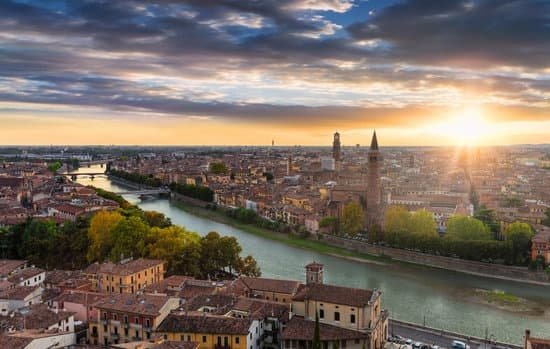Are you looking for a travel guide to World War II sites in Italy? Italy played a significant role in the war, and today, its landscape is dotted with historical sites and memorials that tell the story of this tumultuous period. From battlefields to museums, there are numerous opportunities to explore Italy’s World War II history and pay homage to those who fought and suffered during this time.
Italy’s involvement in World War II is a complex and compelling part of its history. As you embark on a journey to discover the country’s wartime past, you’ll gain a deeper understanding of the impact of the war on Italy’s culture and society. From the ruins of battlefields to the solemn memorials, each site serves as a poignant reminder of the sacrifices made during this turbulent era.
In this article, we will take you on a virtual tour of Italy’s World War II sites, providing an overview of the country’s role in the war and highlighting some of the top historical locations to visit. Whether you’re a history enthusiast or simply curious about Italy’s wartime legacy, this comprehensive guide will help you plan an immersive and educational trip to explore Italy’s World War II history.
Overview of Italy’s Role in World War II
Italy played a complex and significant role in World War II, as it initially aligned with Germany and Japan as part of the Axis powers. However, Italy’s involvement in the war was characterized by internal political struggle, military setbacks, and eventual surrender to the Allies. This section provides an overview of Italy’s role in World War II, highlighting key events and explaining its impact on the country’s history.
During the early years of World War II, Italy under the leadership of Benito Mussolini sought to expand its territory and influence in Europe. In 1939, Italy invaded Albania and later participated in the conquest of Greece. However, its military campaigns suffered from logistical issues and lackluster performance, leading to setbacks that strained its alliance with Germany.
In 1943, faced with mounting losses and Allied advances in North Africa and Sicily, Italy’s King Victor Emmanuel III dismissed Mussolini from power and negotiated an armistice with the Allies. This led to a complex period of Italian history known as the Italian Civil War, with different factions within the country fighting alongside both the Axis powers and the Allies.
Ultimately, Italy officially joined the Allied cause in 1943, contributing troops to the liberation of their own country and further combat operations in Europe.
Top World War II Sites in Italy
Italy is home to a number of significant World War II sites that played a crucial role in the war. From battlefields to memorials, these sites offer visitors an immersive experience and provide valuable insights into Italy’s wartime history. This section will provide a historical overview of some of the top World War II sites in Italy, highlighting their importance and significance in the context of the war.
Monte Cassino: A Key Battle Site
One of the most famous World War II sites in Italy is Monte Cassino, known for the intense and deadly battle that took place there. The Battle of Monte Cassino was a pivotal moment in the Italian campaign, as Allied forces sought to break through German defenses and advance further north.
The monastery at Monte Cassino, which dated back to the 6th century, was heavily bombed during the battle. Today, visitors can explore the ruins of the monastery and the surrounding battlefield, gaining a deeper understanding of the strategic importance of this site.
Anzio Beachhead: D-Day on Italian Soil
The Anzio Beachhead was another crucial location during World War II, serving as the site for Operation Shingle, an amphibious landing carried out by Allied forces in January 1944. The goal was to bypass German defenses further south and gain a foothold near Rome.
However, fierce resistance from German forces led to a protracted and bloody battle. Today, visitors can visit Anzio Beachhead and its surrounding cemeteries and memorials to pay tribute to those who fought and died during this significant military operation.
Museum of Liberation: Remembering Resistance and Struggle
In addition to battlefield sites, Italy is also home to several museums dedicated to preserving the memory of World War II. One notable example is the Museum of Liberation in Rome, which chronicles Italy’s struggle against Fascism and Nazi occupation during the war. Through exhibits, artifacts, and personal stories, visitors can learn about the resistance movements, underground networks, and acts of courage that characterized this tumultuous period in Italian history.
By visiting these diverse World War II sites in Italy, travelers can gain a deeper appreciation for the country’s wartime experiences and understand its lasting impact on culture and society.keyword: a travel guide to world war ii sites in italy.
Visiting the Battlefields
Italy is home to a myriad of World War II sites that offer travelers a chance to immerse themselves in the history and significance of the war. Visiting the battlefields of Italy provides visitors with an opportunity to gain a deeper understanding of the events that unfolded during this tumultuous time period. From the beaches of Anzio to the mountains of Monte Cassino, these sites serve as powerful reminders of the sacrifices made by countless individuals during the war.
One of the most notable battlefields in Italy is the Gustav Line, which extends from the Tyrrhenian Sea to the Adriatic Coast. This strategic defensive line was fiercely contested during World War II and played a critical role in shaping the outcome of the conflict. Today, visitors can explore this area and gain insight into the fierce battles that occurred here, as well as pay their respects at nearby memorials and cemeteries.
In addition to walking through historical battlefields, travelers can also visit preserved bunkers, tunnels, and other wartime structures that offer a tangible connection to Italy’s wartime past. These immersive experiences allow visitors to step back in time and envision what life was like for soldiers and civilians during World War II. By exploring these sites, travelers can gain a deeper appreciation for the impact of war on both a local and global scale.
| World War II Site | Description |
|---|---|
| Gustav Line | A strategic defensive line heavily contested during WWII. |
| Anzio Beachhead | The site of intense fighting between Allied forces and German troops. |
| Monte Cassino | A mountain site where significant battles took place during WWII. |
The Importance of Remembering
Italy is home to numerous memorial sites and museums dedicated to preserving the memory of World War II and honoring those who lost their lives during the conflict. These sites play a crucial role in educating visitors about Italy’s wartime history and the impact of the war on its people. From solemn memorials to informative museums, these locations offer a poignant reminder of the sacrifices made during World War II.
Memorial Sites
One of the most significant memorial sites in Italy is the Commonwealth War Cemetery in Cassino, which honors soldiers from the Commonwealth who died during the Italian campaign. The site is beautifully maintained and provides a peaceful place for reflection and remembrance.
Additionally, the Sicily-Rome American Cemetery and Memorial in Nettuno is a poignant tribute to American soldiers who fought and died in Italy during the war. These memorial sites serve as hallowed ground where visitors can pay their respects to those who made the ultimate sacrifice.
Museums
In addition to memorial sites, Italy also boasts several museums that focus on preserving the history of World War II. The Museum of Liberation in Rome offers insightful exhibits about the Italian resistance movement and the liberation of Rome from Nazi occupation. Visitors can explore artifacts, photographs, and personal accounts that provide a comprehensive understanding of this pivotal period in Italy’s history.
Another notable museum is Museo Storico della Liberazione di Roma, which documents the events leading up to and following Rome’s liberation in 1944. These museums are invaluable resources for anyone seeking to gain a deeper understanding of Italy’s wartime experiences.
By visiting these memorial sites and museums, travelers have the opportunity to gain a greater appreciation for Italy’s role in World War II and pay homage to those who suffered and perished during this tumultuous time. It is vital to remember the sacrifices made by countless individuals as a means of ensuring that such tragic events are never forgotten or repeated.
Educational Outreach
Many of these memorial sites and museums also engage in educational outreach programs aimed at teaching future generations about Italy’s wartime history. Through guided tours, school programs, and special events, these institutions work tirelessly to ensure that the lessons learned from World War II continue to resonate with younger audiences. By actively participating in these initiatives, travelers can contribute to preserving this important aspect of Italy’s heritage for years to come.
Planning Your Visit
Italy offers a wealth of World War II sites for history enthusiasts to visit, from battlefields and memorials to museums and historical landmarks. When planning your visit to these important sites, it’s essential to consider a few key tips and utilize the right resources to make the most of your experience.
First and foremost, consider the best time to visit Italy’s World War II sites. The country experiences peak tourism seasons during the summer months, so visiting during the shoulder seasons of spring and fall can provide a less crowded and more enjoyable experience. Additionally, be sure to check the opening hours and any potential closures of specific sites before your trip.
In terms of resources, there are numerous guidebooks and online resources dedicated to helping travelers navigate Italy’s World War II sites. These resources can provide valuable historical context, maps, recommended itineraries, and tips for making the most of your visit. Additionally, consider guided tours or local experts who can provide in-depth knowledge and insight into these historical locations.
Finally, consider the logistics of traveling between different World War II sites in Italy. The country has an extensive public transportation system, but some remote battlefields or memorials may require a rental car for access. Planning your itinerary carefully and considering transportation options will ensure a smooth and fulfilling journey through Italy’s rich World War II history.
| Tip | Resource |
|---|---|
| Visit during shoulder seasons for fewer crowds | Guidebooks and online resources |
| Check opening hours and potential closures | Guided tours or local experts |
| Consider logistics of traveling between sites | Rental car for remote locations |
The Legacy of World War II in Italy
Italy’s involvement in World War II had a profound impact on the country’s culture and society, shaping its post-war identity and development. The legacy of the war can be seen in various aspects of Italian life, from art and literature to political and social dynamics. Understanding this legacy is crucial for visitors exploring World War II sites in Italy, as it provides context and depth to the historical significance of these locations.
The impact of World War II on Italy’s culture and society can be observed through the following:
- Art and Literature: The war greatly influenced Italian artists and writers, leading to a wave of creative expression that reflected the trauma and challenges of the time. Visiting museums and galleries showcasing works from this period provides insight into how the war shaped artistic movements and narratives in Italy.
- Politics and Governance: World War II had a lasting impact on Italy’s political landscape, leading to significant changes in governance structures and ideologies. Exploring historical sites related to political events during the war allows visitors to understand the context of post-war political developments in Italy.
- Social Dynamics: The war also affected social structures and relationships within Italian society, causing disruptions and transformations that reverberated for years to come. By visiting communities that were impacted by the war, travelers can gain a deeper understanding of how World War II reshaped social dynamics in Italy.
As visitors navigate through World War II sites in Italy, it is important to consider the broader implications of the war on Italian culture and society. This understanding enriches the experience of exploring historical locations, providing a more comprehensive view of Italy’s World War II legacy. By immersing oneself in this aspect of history, travelers can gain a greater appreciation for how the war continues to influence contemporary Italian identity.
Beyond the Battlefield
After the devastation of World War II, Italy faced the enormous task of recovery and reconstruction. The war had left the country with widespread destruction of infrastructure, significant loss of life, and a struggling economy. However, Italy was determined to rebuild and move forward, and the post-war period marked a time of resilience, innovation, and progress.
One notable aspect of Italy’s recovery after World War II was the economic boom known as the “Italian Economic Miracle.” This period, which lasted from the late 1940s to the early 1960s, saw Italy undergo rapid industrialization and modernization. The country experienced unprecedented economic growth, leading to improvements in living standards and a significant increase in infrastructural development. This period laid the foundation for Italy’s emergence as a major global economy.
In addition to economic recovery, Italy also focused on rebuilding its cultural heritage. Many historical sites and landmarks that had been damaged or destroyed during the war were carefully restored. Efforts were made to preserve Italy’s rich artistic and architectural legacy, ensuring that future generations would continue to appreciate the country’s cultural treasures. Today, visitors can witness the impressive restoration work carried out on important monuments and historic buildings that date back centuries.
Italy’s recovery and reconstruction after World War II are integral parts of its history and have significantly shaped its present-day identity. The resilience and determination displayed during this challenging period have left a lasting impact on Italian society and culture.
Recognizing this transformative era is crucial for understanding Italy’s journey from wartime devastation to post-war revival. As travelers explore Italy’s World War II sites, they can also appreciate the remarkable efforts made towards recovery and reconstruction that have contributed to the country’s ongoing legacy.
Conclusion
Italy’s World War II legacy is a complex and multi-faceted part of the country’s history. The sites and memorials that honor this period serve as important reminders of the sacrifices made by the Italian people and the impact of the war on the nation. Visiting these locations provides a unique opportunity to gain a deeper understanding of Italy’s role in World War II and its lasting effects on society, culture, and infrastructure.
As a travel guide to World War II sites in Italy, it is essential to recognize the significance of these historical landmarks in preserving the memory of those who fought and lost their lives during this tumultuous era. From battlefields to museums, each site offers visitors a chance to pay their respects and learn about the events that shaped Italy’s wartime experience.
Furthermore, honoring the past helps to ensure that future generations have access to valuable educational resources about this crucial period in history.
In conclusion, exploring Italy’s World War II legacy through its sites and memorials gives travelers a profound insight into the country’s wartime history. This journey provides an opportunity to reflect on the impact of World War II on Italy and its people while also acknowledging their resilience in rebuilding and moving forward.
Whether you are a history enthusiast or simply interested in gaining a deeper understanding of Italy’s past, visiting these sites allows for an immersive experience that fosters reflection, remembrance, and appreciation for all those who were affected by World War II.
Frequently Asked Questions
What Places Did Italy Invade in Ww2?
Italy invaded several places during World War 2, including Albania, Greece, Egypt, and France. Mussolini’s goal was to expand Italian territories and establish dominance in the Mediterranean region.
What Book Is Set in Italy Ww2?
One of the most famous books set in Italy during World War 2 is “Captain Corelli’s Mandolin” by Louis de Bernières. The novel tells the story of an Italian officer and a young Greek woman during the Italian occupation of Cephalonia.
What Was Italy Famous for in Ww2?
Italy was famous for aligning with Nazi Germany and forming the Axis Powers during World War 2. Italian dictator Benito Mussolini sought to revive the Roman Empire’s former glory and expansionist ambitions, leading to Italy’s military involvement in various campaigns across Europe and North Africa.

I’m a passionate traveler, writer, and Italophile. My fascination with Italy’s history, art, and culture has led me on countless adventures across the Italian landscape. Through “I Live Italy,” I share my love for this extraordinary country and aims to inspire others to explore its boundless beauty.





